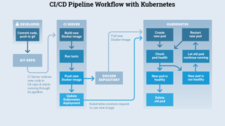TOP 3 KUBERNETES NETWORKING TOOLS AND HOW THEY WORK
Source:- techgenix.com Kubernetes networking is probably the hardest part of working with Kubernetes installations. One of the main reasons is because it has quite specific criteria that need to be met with regards to network architecture. These include requirements such as all pods should be able to communicate with each other without network address translation (NAT) and have a visible IP that they are aware of. This makes getting containers to work in a consistent and secure manner especially difficult
Read more





